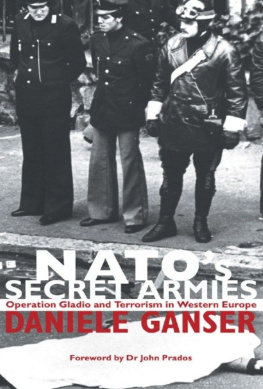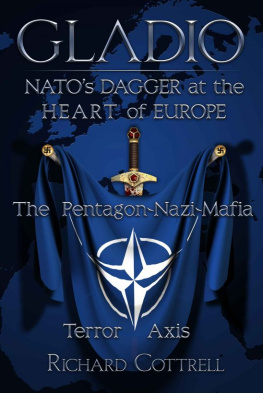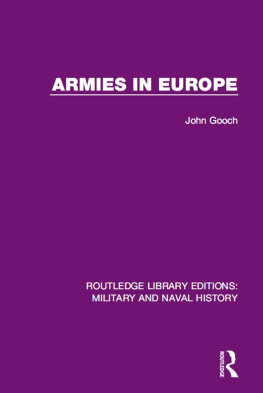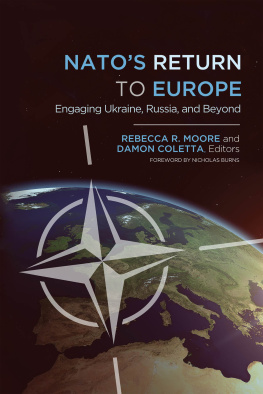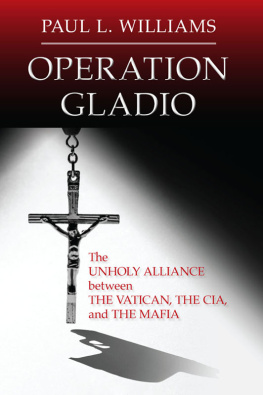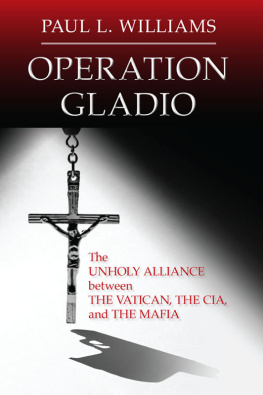NATO's Secret Armies
Operation Gladio and terrorism in Western Europe
by
Daniele Ganser
2005
 ~ Scimus quae legis, et non dicimus ~
~ Scimus quae legis, et non dicimus ~ https://c3jemx2ube5v5zpg.onion
NATO's Secret Armies
Operation Gladio and terrorism in Western Europe
Copyright 2005 Daniele Ganser
Language; English
First Published: 2005 by Frank Cass
ISBN: 0-203-01777-3 (e-book), 0-7146-5607-0 (hbk), 0-7146-8500-3 (pbk)
Edition: Taylor & Francis e-Library, 2005
This book tells the story of NATOs secret anti-Communist stay-behind armies that were set up by the CIA and MI6 after the Second World War in all countries of Western Europe and in some countries became tragically linked to right-wing terrorism.
Contents
About the Book
This book tells the story of NATOs secret anti-Communist stay-behind armies that were set up by the CIA and MI6 after the Second World War in all countries of Western Europe and in some countries became tragically linked to right-wing terrorism.
About the Author
Daniele Ganser is a Senior Researcher at the Center for Security Studies at the Federal Institute of Technology (ETH) in Zurich, Switzerland.
Contemporary Security Studies
MILITARY STABILITY IN EUROPE
The CFE Treaty
Jane M. O. Sharp
MACMILLAN, KHRUSHCHEV AND THE BERLIN CRISIS,
19581960
Kathleen Newman
US NUCLEAR NON-PROLIFERATION POLICY 198997
Tess Oxenstierna
NATOS SECRET ARMIES
Operation Gladio and terrorism in Western Europe
Daniele Ganser
THE US, NATO AND MILITARY BURDEN-SHARING
Stephen Cimbala and Peter Forster
Dedication
TO BEA
I will always admire how you live up to the principles that you perceive to be true, wise and enlightened.
Epigraph
What difference does it make to the dead, the orphans and the homeless, whether the mad destruction is wrought under the name of totalitarianism or the holy name of liberty or democracy?
Mahatma Gandhi (18691948)
The growth of Intelligence abuses reflects a more general failure of our basic institutions.
US Senator Frank Church (1976)
Foreword
At the height of the Cold War there was effectively a front line in Europe. Winston Churchill once called it the Iron Curtain and said it ran from Szczecin on the Baltic Sea to Trieste on the Adriatic Sea. Both sides deployed military power along this line in the expectation of a major combat. The Western European powers created the North Atlantic Treaty Organization (NATO) precisely to fight that expected war but the strength they could marshal remained limited. The Soviet Union, and after the mid-1950s the Soviet Bloc, consistently had greater numbers of troops, tanks, planes, guns, and other equipment. This is not the place to pull apart analyses of the military balance, to dissect issues of quantitative versus qualitative, or rigid versus flexible tactics. Rather the point is that for many years there was a certain expectation that greater numbers would prevail and the Soviets might be capable of taking over all of Europe.
Planning for the day the Cold War turned hot, given the expected Soviet threat, necessarily led to thoughts of how to counter a Russian military occupation of Western Europe. That immediately suggested comparison with the Second World War, when Resistance movements in many European countries had bedevilled Nazi occupiers. In 19391945 the anti-Nazi Resistance forces had had to be improvised. How much the better, reasoned the planners, if the entire enterprise could be prepared and equipped in advance.
The executive agents in the creation of the stay-behind networks were the Central Intelligence Agency (CIA) of the United States and the Secret Intelligence Service (SIS or MI6) of the United Kingdom. Other major actors included security services in a number of European countries. In all cases identical techniques were used. The intelligence services made an effort to establish distinct networks for spying on the occupiers, that is espionage, and for sabotage, or subverting an enemy occupation. To establish the networks the CIA and others recruited individuals willing to participate in these dangerous activities, often allowing such initial, or chief, agents to recruit additional sub-agents. Intelligence services provided some training, placed caches of arms, ammunition, radio equipment, and other items for their networks, and set up regular channels for contact. The degree of cooperation in some cases ranged up to the conduct of exercises with military units or paramilitary forces. The number of recruits for the secret armies ranged from dozens in some nations to hundreds or even thousands in others.
The Resistance example was always an obvious one. Observers of the secret Cold War assumed the existence of the networks; so there are occasional references to the stay-behind networks in spy memoirs and literature. But by and large the subject was acknowledged with a wink and a nod. Until almost the end of the Cold War. In the summer of 1990, after the collapse of Soviet-dominated regimes in Eastern Europe, but prior to the final disintegration of the Soviet Union, the Italian government made public the existence of such a network in that country. Over the years since there has been a recurrent stream of revelations regarding similar networks in many European nations, and in a number of countries there have been official investigations.
For the first time in this book, Daniele Ganser has brought together the full story of the networks the Italians came to call Gladio. This is a significant and disturbing history. The notion of the project in the intelligence services undoubtedly began as an effort to create forces that would remain quiescent until war brought them into play. Instead, in country after country we find the same groups of individuals or cells originally activated for the wartime function beginning to exercise their strength in peacetime political processes. Sometimes these efforts involved violence, even terrorism, and sometimes the terrorists made use of the very equipment furnished to them for their Cold War function. Even worse, police and security services in a number of cases chose to protect the perpetrators of crimes to preserve their Cold War capabilities. These latter actions resulted in the effective suppression of knowledge of Gladio networks long after their activities became not merely counterproductive but dangerous.
Mining evidence from parliamentary inquiries, investigative accounts, documentary sources, trials, and individuals he has interviewed, Ganser tracks the revelation of Gladio in many countries and fills in the record of what these networks actually did. Many of their accomplishments were in fact antidemocratic, undermining the very fabric of the societies they were meant to protect. Moreover, by laying the records in different nations side by side, Gansers research shows a common process at work. That is, networks created to be quiescent became activists in political causes as a rule and not as an exception.
Deep as Dr Gansers research has been, there is a side to the Gladio story he cannot yet reveal. This relates to the purposeful actions of the CIA, MI6 and other intelligence services. Because of the secrecy of government records in the United States, for example, it is still not possible to sketch in detail the CIAs orders to its networks, which could show whether there was a deliberate effort to interfere with political processes in the countries where Gladio networks were active. There were real efforts carried out by Gladio agents but their controllers orders remain in the shadows, so it is not yet possible to establish the extent of the US role overall in the years of the Cold War. The same is true of MI6 for Great Britain and for security services elsewhere. At a minimum Dr Gansers record shows that capabilities created for straightforward purposes as part of the Cold War ultimately turned to more sinister ends. Freedom of Information in the United States provides an avenue to open up government documents; but that process is exceedingly slow and subject to many exemptions, one of which is intended precisely to shield records on activities of this type. The United Kingdom has a rule that releases documents after a certain number of years, but there is a longer interval required for documents of this type, and exceptions are permitted to government when documents are finally released to the public. The information superhighway is barely a macadam path when it comes to throwing light on the truth of the Gladio networks.


